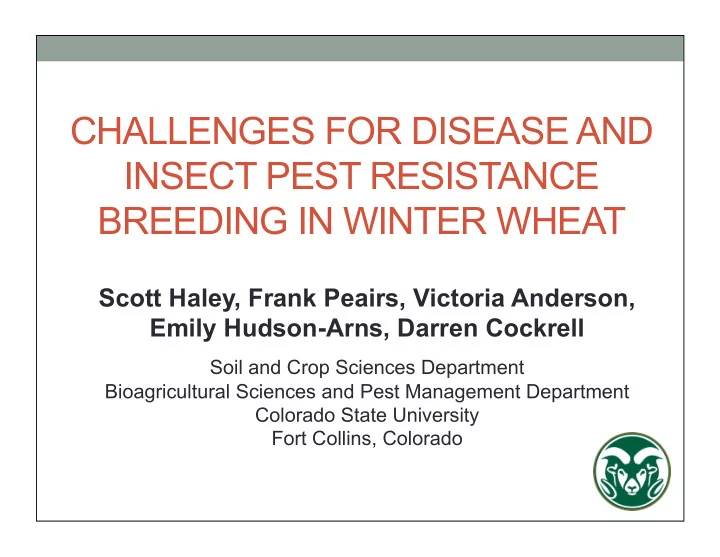

CHALLENGES FOR DISEASE AND INSECT PEST RESISTANCE BREEDING IN WINTER WHEAT Scott Haley, Frank Peairs, Victoria Anderson, Emily Hudson-Arns, Darren Cockrell Soil and Crop Sciences Department Bioagricultural Sciences and Pest Management Department Colorado State University Fort Collins, Colorado
Outline • US High Plains winter wheat production • Stripe (yellow) rust - Evaluation of resistance in breeding - Genotyping by sequencing (GBS) - Use of GBS for association studies - Use of GBS for genomic selection • Wheat stem sawfly - Breeding approaches for solid-stem trait - Field evaluations with hollow stem breeding lines - Multi-trait genomic selection • Breeder perspectives on “durability”
US Wheat Production Regions West-Central Great Plains “High Plains” Courtesy of US Wheat Associates
High Plains Winter Wheat • High elevation, semi-arid - Fort Collins ~ 1600 masl - Mean precip ~ 375 mm/year - Strong N-S ET gradient • Crop cycle - September planting - July harvest • Rainfed production – 90% area - Avg yield – 1.5 to 3.2 MT - Drought stress common • Relatively few critical diseases and insect pests - Russian wheat aphid - Aphids/mite-vectored viruses - Stripe rust, wheat stem sawfly
Stripe Rust (aka Yellow Rust) • Breeding objective only since 2001 • Cool night-time High Plains temperatures favor stripe rust more than other rusts • Important race changes in 2010 and 2012 following original race change in 2000-2001 • Keys for problems in Colorado are moisture in Texas and Oklahoma, Puccinia striiformis May precipitation
Infection Type (IT) 0 1 2 3 4 5 6 7 8 9 Severity (%) 0 1 5 10 20 30 40 50 60 70 80 90 100 Slide courtesy of Xianming Chen, USDA-ARS
Stripe Rust Susceptibility Stripe Rust Resistance score 7-9 score 1-3
Breeding Approaches for Stripe Rust • Crossing – monitor regional/international nurseries • Field selection for resistance - Has worked well – when we get the opportunity! - Cooperative nurseries: Castroville TX (Amir Ibrahim) Rossville KS (Bob Bowden) Pullman WA (Kim Campbell) • Marker-assisted selection for known genes - Marker-assisted backcrossing (parent building) - Preliminary line and doubled haploid screening • Newer tools – genomewide association (GWAS) genomic selection (GS)
Genotyping by Sequencing Elshire et al. (2011) PLoS One 6(5): e19379 10
QYr.tam-2BL Yr17 YR data collection – K.G. Campbell
?????? QRYr6A.3 (?) QRYr6B.1 (?) Yr17 YR data collection – R.L. Bowden
QRYr6B.1 (?)
Elliot L. Heffner, Mark E. Sorrells, and Jean-Luc Jannink Genomic Selection for Crop Improvement Crop Science 49:1-12 (2009) 15
YR data collection – K.G. Campbell
180 unphenotyped individuals YR data collection – K.G. Campbell
180 unphenotyped individuals
Wheat Stem Sawfly • Serious and expanding US wheat production problem - Early 1900s – spring wheat region - 1980s – Montana winter wheat - 2000s – Wyoming winter wheat - 2011 – Colorado winter wheat • Nature of the damage - Inhibits translocation and cuts stem - Affects crop residue persistence • Management - Insecticides – not effective - Cropping – partially effective Photo - R.K.D. Peterson, MT State - Host plant resistance – solid stem Cephus cinctus trait, host-plant “attractiveness”/etc 20
Selected-Bulk Breeding for Stem Solidness Single backcross 2011-12 (SS source/Byrd//Byrd) Increase and bulk 2013 harvest BC 1 F 1 plants Image - Phil Bruckner, MT State • Solid stem assessment Space-plant in bulk 2014 single plant selection - Cut individual stems at soil SS score >15 bulked surface - Assess solidness (1-5 scale), sum Space-plant in bulk over 5 internodes (5-25 scale) single plant selection 2015 SS score >20 advanced • Solid stem parents – MT - Judee 2016 Line Selection (headrows) 800 rows - Bearpaw, Warhorse, MTS1024 2017 Preliminary Line Testing • Adapted parents – CSU 56 lines
Doubled Haploid (DH) Breeding Make cross, grow F1 Pollinate with maize Treat with hormones Collect immature seeds excise embryos transfer to tissue culture Regenerate haploid plants in tissue culture Vernalize, treat with colchicine Harvest DH seed, increase
Doubled Haploid (DH) Breeding Marker-assisted enrichment for Make cross, grow F1 3BL solidness QTL Prior to Pollinate with maize DH production Treat with hormones Bearpaw/Byrd//Byrd Collect immature seeds AA/aa//aa excise embryos transfer to tissue culture 1:1 Aa aa Regenerate haploid ratio plants in tissue culture DNA markers Vernalize, treat with colchicine DH discard Harvest DH seed, increase 12 months 1:1 AA aa to produce ratio
Field Evaluations at New Raymer CO New Raymer, Colorado CSU Elite Trial (2014-2016) Grain Yield Heat Map 25
Field Evaluations at New Raymer CO Stem Cutting Heat Map Grain Yield Heat Map
Field Evaluations at New Raymer CO
Durability of Resistance • Stripe Rust - Multiple race changes, key sources/varieties “defeated” - “The 2016 Colorado wheat crop was the most expensive crop we’ve ever produced” (trial producer/cooperator) - Inconsistency in incidence addressed through use of DNA markers and cooperative evaluations (KS, WA, TX) • Wheat stem sawfly - No evidence for biotypic differences among populations, aside from “host shift” that has already occurred - Solid stem trait – inconsistent expression, “yield drag” - Non solid-stem based resistance may be useful to complement solid-stem trait
Durability of Resistance • Recent technological advancements very useful in an applied breeding context - Ability to pyramid multiple resistance sources - Ability to dissect phenotypes in breeding populations - Shift in the “phenotype-selection” model of plant breeding - Capacity for trait prediction and cross prediction • Challenges - Maintenance of genetic diversity (“breeder’s equation”) - Maintenance of “pyramids” for yield, drought tolerance, sprouting tolerance, herbicide resistance, quality, etc. - Mendelian segregation (we need “cassette gifts”!) - Multiple disease and insect resistances to address
Acknowledgements • Bob Bowden (USDA-ARS Manhattan KS) • Kim Garland-Campbell (USDA-ARS Pullman WA) • Xianming Chen (USDA-ARS Pullman WA) • Luther Talbert (MT State Univ) • Phil Bruckner (MT State Univ) • Mertens Family Farms (New Raymer CO)
Questions?
Recommend
More recommend